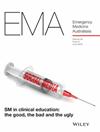Doctors' and Nurses' Perceptions on Barriers and Facilitators to Implementing Clinical Pharmacy Services in the Emergency Department in Singapore
Abstract
Background
Emergency Medicine (EM) clinical pharmacy services are an increasingly widespread practice globally and have been shown to improve patient safety and care in the high-risk environment of the emergency department (ED). However, limited information is published on the implementation barriers and facilitators of these services. This study assessed the current needs of ED doctors and nurses in Singapore General Hospital (SGH) and evaluated their perceptions towards EM clinical pharmacy services. Barriers and facilitators to the implementation of these services in the new SGH EM building were further explored.
Methods
An anonymous survey was sent to all SGH ED doctors and nurses to assess their perceptions towards EM clinical pharmacy services. Qualitative data on barriers and facilitators were explored through open-ended questions in the survey and semi-structured interviews. Qualitative data were analysed via thematic analysis using the Consolidated Framework of Implementation Research.
Results
A total of 205 survey responses were collected, and seven interviews were conducted. The top-ranked services identified were drug information consultation, facilitating timely treatment of emergency conditions, and providing staff and patient education. Pertinent barriers to the implementation of the services comprised cost, culture, compatibility, and staffing. Key facilitators included the relative advantage of the services, tension for change within SGH ED, tailoring strategies, and engaging doctors and nurses during the implementation process.
Conclusion
ED doctors and nurses favourably perceived EM clinical pharmacy services. Strategies to implement the services should be tailored to address barriers and leverage facilitators identified for successful implementation within the local ED context.

 求助内容:
求助内容: 应助结果提醒方式:
应助结果提醒方式:


